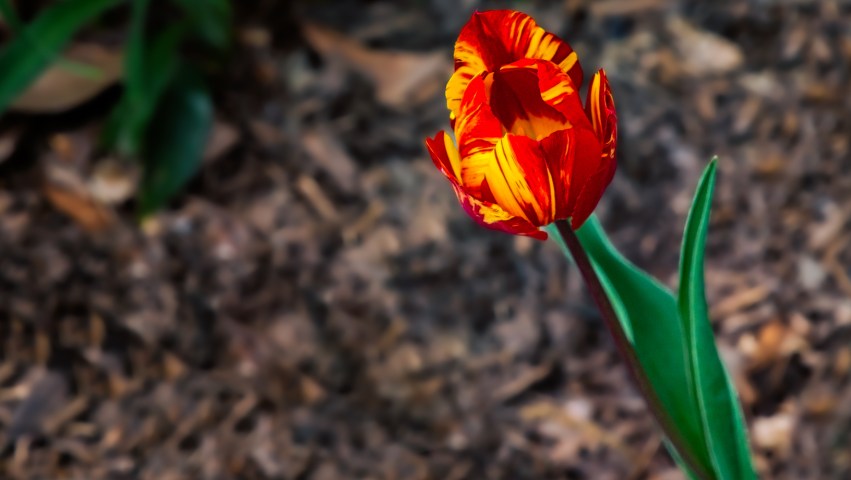From “Wild Tulips” in Tulip (Botanical) by Celia Fisher:
“Once upon a time — as all the best stories begin — tulips grew unnamed and various in the valleys and slopes between distant mountain ranges. Their bulbs enabled them to endure ice-cold winters and fierce summer heat, in contrast to which the gentle sunshine and showers of springtime made them burst into flower. Their variations of colour, shape, size and other more intimate features must have been prompted by adaptations to their environment but seem also to be full of joie de vivre….
“[Tulipa sylvestris] was first recorded growing in Italy in the sixteenth century but only around cultivated land, especially vineyards, and even as far east as Tabriz. Its discovery in 1927 was described thus: ‘It occurs here mainly if not exclusively in orchards. It is sold in the streets in April towards the end of the month’ — both facts providing valuable clues that T. sylvestris was, many centuries ago, gathered in the wild for its appeal as a spring flower and spread happily (being stoloniferous) until it became a weed of cultivation….
“In Europe, naturalized colonies occur in France, Germany, Switzerland, the Netherlands, England, Sweden and even Norway, where it can be found near seaports. Since ships once carried soil as ballast, which at the end of the voyage might be dumped near the port, this is another clue to the journey of T. sylvestris. Possibly the English colonies were brought by the Romans with their vines, but if so they remained unrecorded for a long while. T. sylvestris is a tulip of golden charm, with a spicy scent and oriental pointed petals that curve back at the tips even in bud. The flower droops a little on its tall, swaying stem and the backs of the petals are darkly shadowed with grey/green. They open a little untidily and sometimes the petals number up to eight…”
From “Up at a Villa — Down in the City” by Robert Browning in Browning: Poetry and Prose, selected by Simon Nowell-Smith:
Is it better in May, I ask you? you’ve summer all at once;
In a day he leaps complete with a few strong April suns!
‘Mid the sharp short emerald wheat, scarce risen three
fingers well,
The wild tulip, at end of its tube, blows out its great red
bell,
Like a thin clear bubble of blood, for the children to pick
and sell….
From “A Children’s Poem” by Manocher Movlai in Flame of the Uncharted Heart: Essential Poetry, selected by Jon Schreiber:
Look at the wild tulips.
The sun has filled them up with Life.
Now they’ve opened,
offering the resin of the Sun
to the honey bees,
who don’t mind if the little birds enjoy
a taste of heaven themselves….
Hello!
Here we have clusters and closeups of Tulipa sylvestris — tiny tulips commonly called Wild Tulips or Woodland Tulips, and sometimes historically referred to as Florentine Tulips after their abundant, natural occurrence in antique Italy. I don’t see too many of these around my ‘hood — mostly at Oakland Cemetery, where I photographed these — so I like to think of them as exotic and unusual, but perhaps I should not. They are striking, though, especially when photographed to show off some of the red and orange colors on the unopened flowers, or from a slightly upward angle to capture how those colors contrast with the yellow of the rest of the petals from below.
As is apparent from the photographs, I took these on one of those excellent overcast days where sunlight is softened as it peers through the clouds. Until I started working on the photos, however, I hadn’t expected many of them to look like they’re glowing. That glow is very evident on the first five; then varies in intensity on some of the others but is visible wherever yellow/orange colors of the backs of petals contrast with darker colors, shades of purple and red. Most of the photos came out of the camera quite flat, like this…

… which I expected because of the overcast lighting conditions. At import, Lightroom is showing me the image as the camera captured it, based on the settings I chose — and yet the camera’s sensor has captured so much additional color and detail that this is like an image just waiting to be elevated.
With minor adjustments to basic settings in Lightroom (reducing highlights and whites, adding some contrast, and a little bit of texture), the details and contrasting colors that are actually present in the flower petals are revealed. I then create the “glow” effect by altering the relationships between the colors (but not changing their hues) so that the orange and yellow colors contrast more starkly with the purple and red colors.
The result…

… is similar to the shimmering effect created by red letters on a blue background or vice versa (see Chromostereopsis) — and is actually a perceptual illusion. While I often try to photograph flowers with side-lighting and backlighting to let sunlight add glow to some of the flower petals — this is quite effective with irises, for example, when lighting conditions favor it and the flowers are translucent — this is the first time I’ve tried to do it with flowers like these. They’re not translucent (despite their small size, the flower’s petals are quite thick), so light doesn’t really pass through them, but creating greater contrast between the available colors seems to yield similar results. Of course, I do like my photo manipulations and certainly like playing in the “illusion space” — so I think I’ll try repeating this approach with other flower photos.
Thanks for reading and taking a look!



















































































































